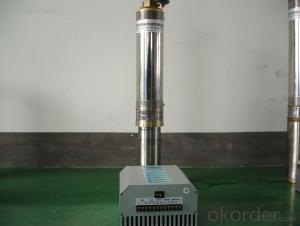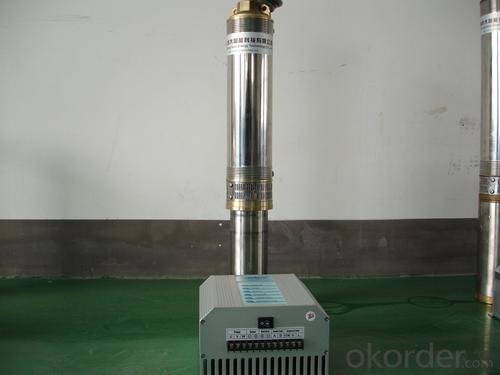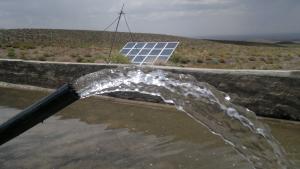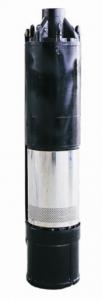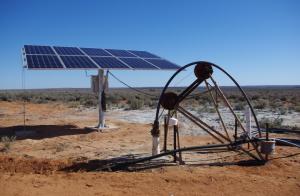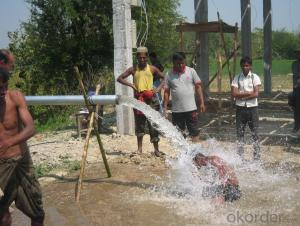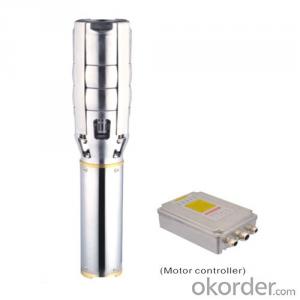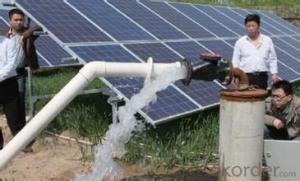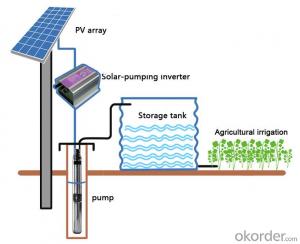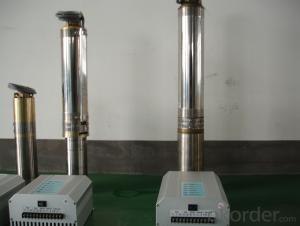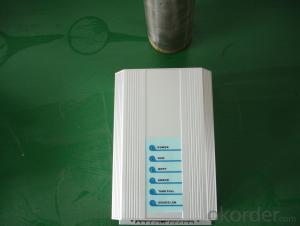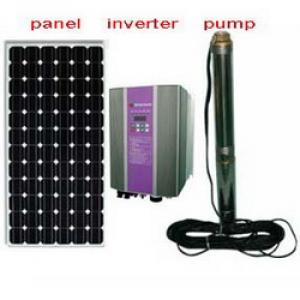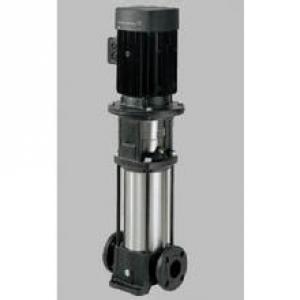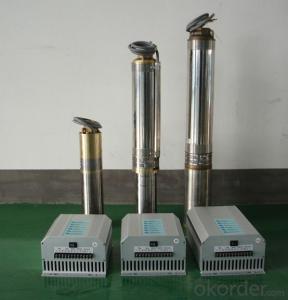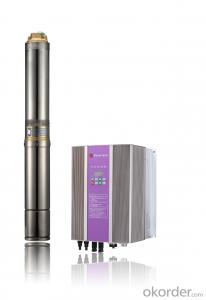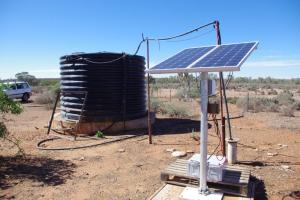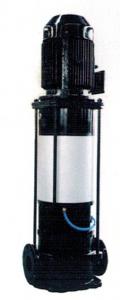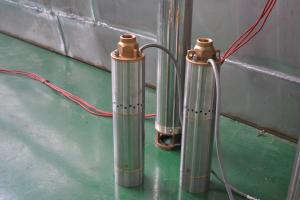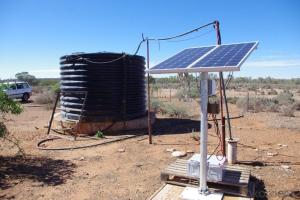Sunnydaze Solar DC Solar Pump
- Loading Port:
- China Main Port
- Payment Terms:
- TT OR LC
- Min Order Qty:
- -
- Supply Capability:
- -
OKorder Service Pledge
OKorder Financial Service
You Might Also Like
Item Description :
This superb new addition to our solar fountain range comes with a 10w solar panel,and a powerful fountain pump that is capable of producing fountains of up to 2m in height. As well as being easy to set up and use.Instruction manual is supplied for assembly and maintenance.
Solar Fountain Key Features :
Powered by direct sunlight
No high voltage electric mains required
Safe for children
Max. height of fountain: 2M
Max. flow capacity: 800 L/H(176 GAL)
10W Polycrystalline solar panel included
18V DC brushless pump
Solar Pump Features :
Can produce fountains up to : 2M (tube height) 1.4M (fountain height)
Comes with multiple nozzle accessories
Cable Length : 5M
Solar Panel Features :
10W peak power.
Polycrystalline highly efficient solar panel
Comes mounted in aluminium frame
Comes with ground stake and rotating knob so you can angle your panel toward the sun
What You Will Get :
10W solar panel
Solar pump
Ground Sake
Nozzle accessories
Precautions :
DO NOT alter or change the product itself or its components
Operate pump in freshwater only, never above 50 degrees celsius
Keep away from flammable liquids
Do not connect to any other power supply other than the included
- Q: Are there any safety measures or precautions to consider when using a solar pump?
- When using a solar pump, it is important to consider various safety measures and precautions. These are: 1. Electrical Safety: Solar pumps have the potential to generate electricity, so it is crucial to adhere to electrical safety guidelines. Ensure that all wiring and connections are adequately insulated and protected from water or physical damage. Use a circuit breaker or disconnect switch to cut off power during maintenance or repairs. 2. Water Safety: When working with a solar pump that draws water from a well or pond, be cautious of possible water contamination. Utilize an appropriate filtration system to remove impurities and regularly clean and disinfect the water source. Additionally, make sure the pump is properly sealed to prevent water from entering critical components. 3. Overheating Prevention: Solar pumps rely on sunlight to generate power, and excessive heat can decrease their efficiency or cause damage. Install the pump in a shaded area or use a protective cover to shield it from direct sunlight, particularly during peak hours. Regularly check for signs of overheating, such as melted wires or burnt odors. 4. Maintenance and Inspection: Regular maintenance and inspections are vital to ensure the safe and efficient operation of a solar pump. Adhere to the manufacturer's guidelines for routine checks, cleaning, and lubrication. Inspect the pump's components, including panels, wiring, and valves, for any indications of wear or damage. Address any issues promptly to prevent further complications. 5. Installation and Mounting: When installing a solar pump, carefully follow the manufacturer's instructions and guidelines. Ensure that the pump is securely mounted to prevent accidental falls or damage. Use appropriate mounting brackets or structures that can withstand the weight and environmental conditions. 6. Training and Education: It is essential to have adequate knowledge and training regarding the operation of solar pumps. Understand the specific features, controls, and safety precautions of the pump. If necessary, seek professional assistance or training to ensure safe and effective usage. By adhering to these safety measures and precautions, users can minimize the risk of accidents, optimize the performance of their solar pump, and ensure its longevity.
- Q: How does a solar pump handle water contamination or impurities?
- A solar pump does not directly handle water contamination or impurities. However, it can be paired with appropriate water treatment systems or filters to address these issues.
- Q: Can a solar pump be used in areas with limited access to backup battery systems?
- Yes, a solar pump can be used in areas with limited access to backup battery systems. Solar pumps work by converting sunlight into electricity to power the pump, eliminating the need for a backup battery system. This makes them ideal for remote or off-grid locations where access to reliable electricity or backup battery systems may be limited.
- Q: Can a solar pump be used for water supply in public parks or recreational areas?
- Certainly, water supply in public parks or recreational areas can be achieved using a solar pump. Solar pumps present a sustainable and environmentally friendly option for pumping water by harnessing the energy of the sun to power the pump. They prove to be highly advantageous in areas where electricity access may be limited or unreliable. Solar pumps can be employed to extract water from nearby sources like ponds, lakes, or underground wells. This water can then be distributed to public park features such as fountains, sprinkler systems, or other water elements. Moreover, these pumps can also fill up water tanks that can be distributed throughout the park for various purposes, including irrigation, drinking water supply, and recreational water activities. Utilizing solar pumps for water supply in public parks comes with significant benefits. Notably, these pumps operate silently and emit zero emissions, thereby creating a peaceful and clean environment. Additionally, solar pumps necessitate minimal maintenance, resulting in reduced overall operating costs and making them a cost-effective option in the long term. In summary, solar pumps offer an efficient and sustainable solution for water supply in public parks or recreational areas. They ensure a constant and reliable water source while minimizing the adverse impact on the environment.
- Q: Can solar pumps be used for dewatering or flood control?
- Yes, solar pumps can be used for dewatering or flood control. These pumps utilize solar energy to power their operation, making them an environmentally friendly option for managing water levels during dewatering or flood situations. They can be used to drain water from flooded areas or control water levels in ditches, ponds, or other water bodies, providing an effective and sustainable solution for flood control and dewatering purposes.
- Q: Are there different types of solar pumps available?
- Yes, there are various types of solar pumps available, including submersible solar pumps, surface solar pumps, and solar-powered irrigation systems. Each type is designed for specific applications and offers different features and benefits.
- Q: Can a solar pump be remotely monitored or controlled?
- Yes, a solar pump can be remotely monitored and controlled. With the advancement in technology, many solar pumps are now equipped with remote monitoring and control systems. These systems typically use wireless communication technologies such as GSM, GPRS, or satellite communication to enable remote access to the pump's performance data and control functions. Remote monitoring allows users to track the pump's operation, performance, and energy production in real-time from a central location. This information includes data such as water flow rates, power output, system efficiency, and battery charge levels. It helps in identifying any issues or inefficiencies promptly, allowing for timely maintenance or adjustments to optimize the pump's performance. Furthermore, remote control capabilities enable users to remotely operate and control the pump's functionality. This can include starting or stopping the pump, adjusting the speed or flow rate, changing the operational mode, or even toggling on/off the pump's power supply. These control features provide convenience and flexibility, especially in situations where physical access to the pump may be challenging or time-consuming. Overall, remote monitoring and control of solar pumps offer significant benefits in terms of efficiency, convenience, and cost savings. It allows for proactive maintenance, efficient energy management, and the ability to respond promptly to any issues or changes in operating conditions.
- Q: How does the efficiency of a solar pump system vary with different pipe sizes?
- The efficiency of a solar pump system can vary depending on the size of the pipes used. The flow rate and pressure of the system are directly influenced by the size of the pipes. In general, when larger pipes are used, the flow rates can be increased and the pressure losses can be reduced. This results in higher efficiency because larger pipes have less friction, allowing the water to flow more easily. Consequently, the pump does not have to exert as much effort to move the water through the system, which leads to improved energy efficiency. On the contrary, if smaller pipes are used, there can be increased pressure losses and reduced flow rates. This can adversely affect the efficiency of the solar pump system. Smaller pipes have more friction, causing the pump to work harder in order to maintain the desired flow rate. This can result in higher energy consumption and reduced efficiency. It is important to consider that the optimal pipe size for a solar pump system depends on various factors, such as the desired flow rate, distance, elevation changes, and the capabilities of the specific pump being used. Seeking advice from a professional or conducting hydraulic calculations can help determine the ideal pipe size for a given system, ensuring maximum efficiency.
- Q: Can solar pumps be used for water supply in remote forestry or logging sites?
- Yes, solar pumps can be used for water supply in remote forestry or logging sites. Solar pumps are a reliable and sustainable option for water pumping in remote areas where grid electricity may not be available. They can efficiently extract water from boreholes, wells, or other water sources, providing a consistent water supply for various forestry or logging activities. Additionally, solar pumps require minimal maintenance and operating costs, making them an ideal choice for off-grid locations.
- Q: Can a solar pump work at night?
- It is not possible for a solar pump to function during the night since its operational power is dependent on sunlight. Solar pumps utilize photovoltaic panels to convert sunlight into electricity, which is subsequently utilized to power the pump. In the absence of sunlight, the pump lacks an energy source to operate. Nevertheless, certain solar pumps may possess the ability to store surplus energy produced during daylight hours in batteries, which can then be used to power the pump at night or on cloudy days. These batteries serve as an alternative power supply in the absence of sunlight.
Send your message to us
Sunnydaze Solar DC Solar Pump
- Loading Port:
- China Main Port
- Payment Terms:
- TT OR LC
- Min Order Qty:
- -
- Supply Capability:
- -
OKorder Service Pledge
OKorder Financial Service
Similar products
Hot products
Hot Searches
Related keywords
